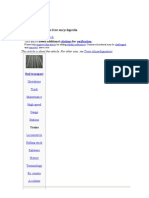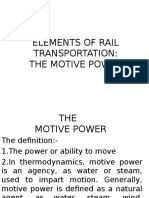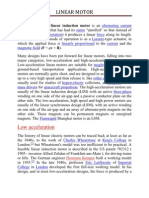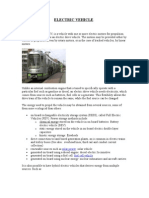Parul Institute of Engineering & Technology
Parul Institute of Engineering & Technology
Uploaded by
rworld999Copyright:
Available Formats
Parul Institute of Engineering & Technology
Parul Institute of Engineering & Technology
Uploaded by
rworld999Original Title
Copyright
Available Formats
Share this document
Did you find this document useful?
Is this content inappropriate?
Copyright:
Available Formats
Parul Institute of Engineering & Technology
Parul Institute of Engineering & Technology
Uploaded by
rworld999Copyright:
Available Formats
Parul Institute of Engineering &
Technology
Name Of Subject :EPU&T
Name of Unit :Locomotive
Topic : locomotive, trumways, trollys,track
Name of Faculty :Pratik Patel
Name of Studnets: (1)Ambarish upadhyay(27)
(2)Dhananjay chauhan(28)
LOCOMOTIVE
This article is about locomotives that run on rails.
For the type of heavy-haulage traction engine, see
Road locomotive (disambiguation). For the Russian
football club, see FC Lokomotiv Moscow. For the
1960s British band, see Locomotive (band).
Three body styles of diesel locomotive: cab unit,
hood unit and box cab. These locomotives are
operated by Pacific National in Australia.
Rail transport
Operations
Track
Maintenance
High-speed
Gauge
Stations
Trains
Locomotives
Rolling stock
Companies
History
Attractions
Terminology
By country
Accidents
Modelling
This box: view talk edit
R class steam locomotive number R707 as operated by the Victorian Railways of Australia.
A Green Cargo RC 4 class electric locomotive repainted in its original livery
for the Swedish 150-year railway anniversary in 2006.
A locomotive is a railway vehicle that provides the motive power for a train.
The word originates from the Latin loco "from a place", ablative of locus,
"place" + Medieval Latin motivus, "causing motion", and is a shortened
form of the term locomotive engine,[1] first used in the early 19th century
to distinguish between mobile and stationary steam engines.
A locomotive has no payload capacity of its own, and its sole purpose is to
move the train along the tracks. In contrast, some trains have self-propelled
payload-carrying vehicles. These are not normally considered locomotives,
and may be referred to as multiple units, motor coaches or railcars. The use
of these self-propelled vehicles is increasingly common for passenger trains,
but rare for freight (see CargoSprinter). Vehicles which provide motive
power to haul an unpowered train, but are not generally considered
locomotives because they have payload space or are rarely detached from
their trains, are known as power cars.
Traditionally, locomotives pull trains from the front.
Increasingly common outside North America is push-
pull operation, where one locomotive pulls the train
from the front and another locomotive pushes it from
behind. In this arrangement the locomotive at the
rear of the train is controlled from a control cab at the
front of the train. Push-pull operation is generally
infeasible in North America as, even if mid-train or
tail-end "helpers" are provided, the front-end might
have over 26,000 horsepower, net for traction,
whereas the mid-train and/or tail-end "helpers" might
have only 9,000 horsepower, net for traction.
Electrification
Electrification is the process of powering by electricity and is
usually associated with changing over from another power
source. The broad meaning of the term, such as in the history
of technology and economic history, usually applies to a
region or national economy. Broadly speaking, electrification
was the build out of the electrical generating and distribution
systems which occurred in the United States, Britain and other
countries from the mid 1880's until around 1940 and is in
progress in rural areas in some developing countries. This
included the change over from line shaft and belt drive using
steam engines and water power to electric motors
The electrification of particular sectors of the economy
is called by terms such as factory electrification,
household electrification, rural electrification or railway
electrification. It may also apply to changing industrial
processes such as smelting, melting, separating or
refining from coal or coke heating or chemical processes
to some type of electric process such as electric arc
furnace, electric induction or resistance heating or
electrolysis or electrolytic separating.
Electrification was called "the greatest engineering
achievement of the 20th Century" by the National
Academy of Engineering
TRACK
The track on a railway or railroad, also known as the
permanent way, is the structure consisting of the
rails, fasteners, sleepers and ballast (or slab track),
plus the underlying subgrade. For clarity it is often
referred to as railway track (British English and UIC
terminology) or railroad track (predominantly in the
United States).
The term permanent way also refers to the track in
addition to lineside structures such as fences etc
You might also like
- Uic 612Document142 pagesUic 612gabiunNo ratings yet
- Class 319 Electric Multiple UnitDocument20 pagesClass 319 Electric Multiple UnitThiagoCTCNo ratings yet
- Polish Railway Timetable Info PDFDocument15 pagesPolish Railway Timetable Info PDFGazz 292No ratings yet
- Trains Magazine Locotrol FeatureDocument6 pagesTrains Magazine Locotrol FeatureRaj ThakurNo ratings yet
- Theoretical Framework Inventory ManagementDocument83 pagesTheoretical Framework Inventory ManagementAnil Kumar Singh57% (21)
- TecRec 20 v2 Signed UploadedDocument59 pagesTecRec 20 v2 Signed Uploadedברוך שרוןNo ratings yet
- Draft Revision of IRCA Part IVDocument283 pagesDraft Revision of IRCA Part IVManoj Bairwa60% (5)
- Gmrt2130 Iss 3Document42 pagesGmrt2130 Iss 3yadvikram7100% (1)
- Introduction To Railroad EngineeringDocument15 pagesIntroduction To Railroad EngineeringChristian RigonNo ratings yet
- Rail Transport Vehicle Motive Power Train Ablative: LatinDocument21 pagesRail Transport Vehicle Motive Power Train Ablative: LatinVaseem BakerNo ratings yet
- Railway Electric Traction - WikipediaDocument13 pagesRailway Electric Traction - WikipediasajalNo ratings yet
- LocomotiveDocument19 pagesLocomotiveanulekha1991No ratings yet
- Rolling StockDocument27 pagesRolling StockJizelle HascoNo ratings yet
- Description For TrainDocument2 pagesDescription For TrainArifNo ratings yet
- Train: From Wikipedia, The Free EncyclopediaDocument14 pagesTrain: From Wikipedia, The Free EncyclopediaAldo AvilaNo ratings yet
- Electric Locomotive - WikipediaDocument48 pagesElectric Locomotive - WikipediaDeepali JadonNo ratings yet
- Rolling StockDocument11 pagesRolling Stockshiva_ssk17No ratings yet
- A TrainDocument6 pagesA TrainX Angels Print Zone KotikawattaNo ratings yet
- HMT 803Document19 pagesHMT 803Husen AliNo ratings yet
- Tx920fx60r Version1 The History and Evolution of The American RailroadDocument130 pagesTx920fx60r Version1 The History and Evolution of The American RailroadAndrei RobaNo ratings yet
- WK 7 - Rail TransportDocument9 pagesWK 7 - Rail TransportErica PradoNo ratings yet
- Top 10 Most Luxurious TrainsDocument74 pagesTop 10 Most Luxurious TrainsHusen AliNo ratings yet
- Range-Extended Electric VehicleDocument2 pagesRange-Extended Electric VehiclekarthikerukullaNo ratings yet
- Electric Locomotive and Traction Installation: (A Central University)Document22 pagesElectric Locomotive and Traction Installation: (A Central University)ajay bhaskarNo ratings yet
- Electic LocoDocument20 pagesElectic LocoNitishBHATIA100% (1)
- Making Tracks: A Whistle-stop Tour of Railway HistoryFrom EverandMaking Tracks: A Whistle-stop Tour of Railway HistoryRating: 2.5 out of 5 stars2.5/5 (1)
- Diesel LocomotiveDocument74 pagesDiesel LocomotiveVikas GuptaNo ratings yet
- Ce2303 NolDocument65 pagesCe2303 NolCindy JonesNo ratings yet
- Types of TrainsDocument12 pagesTypes of TrainsMostafa AfifyNo ratings yet
- Elements of Rail Transportation: The Motive PowerDocument31 pagesElements of Rail Transportation: The Motive Powershuting2teoh0% (1)
- Project Report On Electric Loco, TuglakabaadDocument39 pagesProject Report On Electric Loco, TuglakabaadSaurabh Madeel88% (8)
- Topic 1 - Introduction To Railway Electrification TechnologiesDocument95 pagesTopic 1 - Introduction To Railway Electrification TechnologiesRyanNo ratings yet
- Train 02Document1 pageTrain 02ptia ptohptNo ratings yet
- Third RailDocument20 pagesThird RailrhusmenNo ratings yet
- Merry-Go-Round Train: Balloon LoopDocument3 pagesMerry-Go-Round Train: Balloon Looprohit21107053No ratings yet
- Railway Station Design (B.arch Thesis)Document9 pagesRailway Station Design (B.arch Thesis)Nasim Ahmad43% (7)
- TrainDocument3 pagesTrainintextu585No ratings yet
- Works Trams of the British Isles: A Survey of Tramway Engineers' VehiclesFrom EverandWorks Trams of the British Isles: A Survey of Tramway Engineers' VehiclesNo ratings yet
- Electro-Diesels v6Document14 pagesElectro-Diesels v6Nuh AinuhaNo ratings yet
- Old Steam LocomotiveDocument55 pagesOld Steam LocomotivemmkattaNo ratings yet
- Electric Traction: A Vital Development in The History of The RailwayDocument5 pagesElectric Traction: A Vital Development in The History of The RailwayRaghavan Veera SundaramNo ratings yet
- 8b Rail TransportationDocument14 pages8b Rail TransportationJohn Joseph AmilerNo ratings yet
- Trains Magazine Locotrol FeatureDocument6 pagesTrains Magazine Locotrol FeatureFurtado23No ratings yet
- Classic American Locomotives: The 1909 Classic on Steam Locomotive TechnologyFrom EverandClassic American Locomotives: The 1909 Classic on Steam Locomotive TechnologyNo ratings yet
- Role of Rail Transport in Tourism IndustryDocument45 pagesRole of Rail Transport in Tourism IndustryGLOBAL INFO-TECH KUMBAKONAMNo ratings yet
- Electric TractionDocument22 pagesElectric TractionRubia IftikharNo ratings yet
- History of RailwaysDocument3 pagesHistory of Railwaysantoniosviben519No ratings yet
- Tesla's Electric MotorsDocument5 pagesTesla's Electric MotorsFlavius LunguNo ratings yet
- A Linear Motor or Linear Induction Motor Is An Alternating CurrentDocument6 pagesA Linear Motor or Linear Induction Motor Is An Alternating CurrentAnand KanaujiyaNo ratings yet
- TrainsDocument3 pagesTrainssmejalenkaNo ratings yet
- One Introduction To Railway EngineeringDocument31 pagesOne Introduction To Railway EngineeringAndualem KidusNo ratings yet
- Rail Transport: Done By:Oboroc Ana-Maria EMREI 145Document18 pagesRail Transport: Done By:Oboroc Ana-Maria EMREI 145Ana MariaNo ratings yet
- Introduction To Railway Engineering SystemsDocument43 pagesIntroduction To Railway Engineering SystemsBlessings MushayiNo ratings yet
- Chapter 9 - Railway Electrification PDFDocument51 pagesChapter 9 - Railway Electrification PDFhariridk100% (4)
- Electricity in Locomotion: An Account of Its Mechanism, Its Achievements, and Its ProspectsFrom EverandElectricity in Locomotion: An Account of Its Mechanism, Its Achievements, and Its ProspectsNo ratings yet
- Toaz - Info The Railway Track PR - 11Document5 pagesToaz - Info The Railway Track PR - 11ibrahimkeith004No ratings yet
- Evolución Del Ferrocarril en El EcuadorDocument18 pagesEvolución Del Ferrocarril en El EcuadorCristianeugenio100% (1)
- Electric VehiclesDocument15 pagesElectric VehiclesJai ChawlaNo ratings yet
- Ijcrt 188711Document5 pagesIjcrt 188711Joseph StalinNo ratings yet
- A Review On Technology in Locomotives of Indian Railways: Rolga Roy, Stephy Johny & Arsha SDocument4 pagesA Review On Technology in Locomotives of Indian Railways: Rolga Roy, Stephy Johny & Arsha SAarsha PSNo ratings yet
- Lec1 Introduction To Railway Engineering 20Document42 pagesLec1 Introduction To Railway Engineering 20م.علي سعدي الجنابيNo ratings yet
- The Home University Encyclopedia Vol VDocument420 pagesThe Home University Encyclopedia Vol VBranko NikolicNo ratings yet
- Working Timetable: Book CGDocument10 pagesWorking Timetable: Book CGLewis BellNo ratings yet
- Mitsubishi Electric To Supply Railway Systems For TFNSWDocument2 pagesMitsubishi Electric To Supply Railway Systems For TFNSWRizki Fajar NovantoNo ratings yet
- Points To Be Emphasized-1. About The Company: (A) When It Was Originated, History?Document51 pagesPoints To Be Emphasized-1. About The Company: (A) When It Was Originated, History?rasel0% (1)
- Thesis Statement: KTM Services Are Still Unsatisfactory. 1. Inefficiency of ServicesDocument3 pagesThesis Statement: KTM Services Are Still Unsatisfactory. 1. Inefficiency of Servicesmomoe8No ratings yet
- Final MINUTES For 63rd ESC Meeting 17.03.2020Document59 pagesFinal MINUTES For 63rd ESC Meeting 17.03.2020Girish YadavNo ratings yet
- Best Practices and Strategies For High Speed Rail EnergyDocument98 pagesBest Practices and Strategies For High Speed Rail Energythuy giangNo ratings yet
- An Organizational Study at Integral Coach FactoryDocument88 pagesAn Organizational Study at Integral Coach FactorySubbu Dublu100% (1)
- Rolling Stock 2Document128 pagesRolling Stock 2Ren Bautista67% (3)
- Outline of TransportDocument10 pagesOutline of Transportdobojac73No ratings yet
- List of SectorsDocument33 pagesList of SectorsGhayas Ud-din DarNo ratings yet
- Irs R-48-88Document16 pagesIrs R-48-88sankar.kepro.labNo ratings yet
- Kereta API 2019-1Document56 pagesKereta API 2019-1DeniShafrisar100% (1)
- Inventory Management Rekha FinalDocument80 pagesInventory Management Rekha FinalMoses David100% (2)
- Modelling, Simulation and Monitoring of IM For EMU TrainDocument6 pagesModelling, Simulation and Monitoring of IM For EMU Trainjaroldane1000No ratings yet
- Vem MotorsDocument18 pagesVem Motorscosty_transNo ratings yet
- RECOMMENDATION N°006REC1072-1 OF The European Union Agency For RailwaysDocument13 pagesRECOMMENDATION N°006REC1072-1 OF The European Union Agency For Railwaysllauro2010No ratings yet
- DESIRO UK Electrical Multiple Unit FamilyDocument4 pagesDESIRO UK Electrical Multiple Unit FamilyVíctor FaucheretNo ratings yet
- Traverser PresentationDocument25 pagesTraverser PresentationAmin PaniwalaNo ratings yet
- Annex 2 Project Description For ScopingDocument15 pagesAnnex 2 Project Description For ScopingJulie Ann MiguelNo ratings yet
- IBX MemoDocument24 pagesIBX MemoChristina WilkinsonNo ratings yet
- Chapter III EditedDocument43 pagesChapter III EditedthreephasefaultNo ratings yet
- Types of TrainsDocument12 pagesTypes of TrainsMostafa AfifyNo ratings yet
- Booklet On Traction Motor and Gear Box of Train SetDocument41 pagesBooklet On Traction Motor and Gear Box of Train SetDeepak AsokanNo ratings yet
























































































